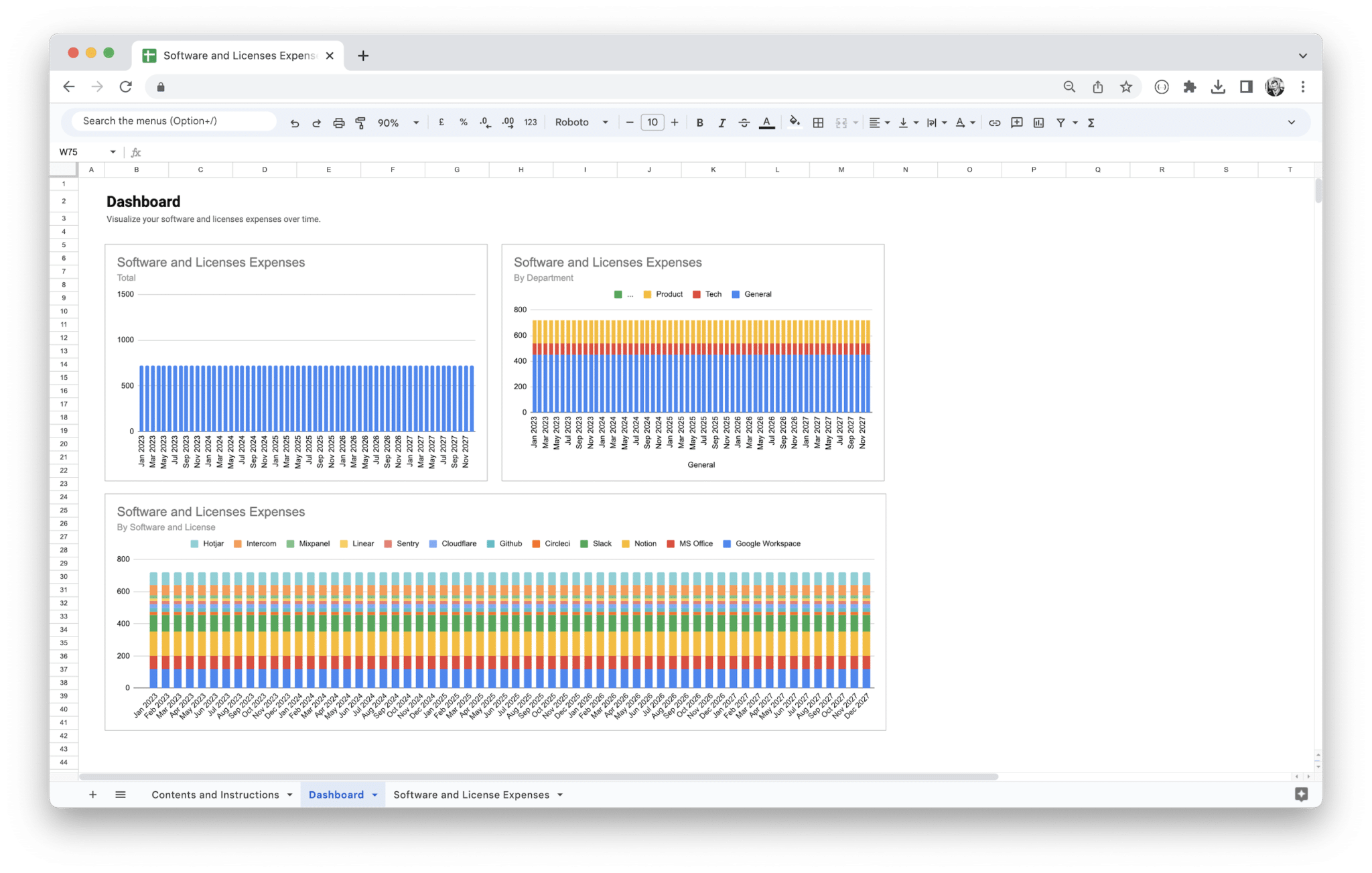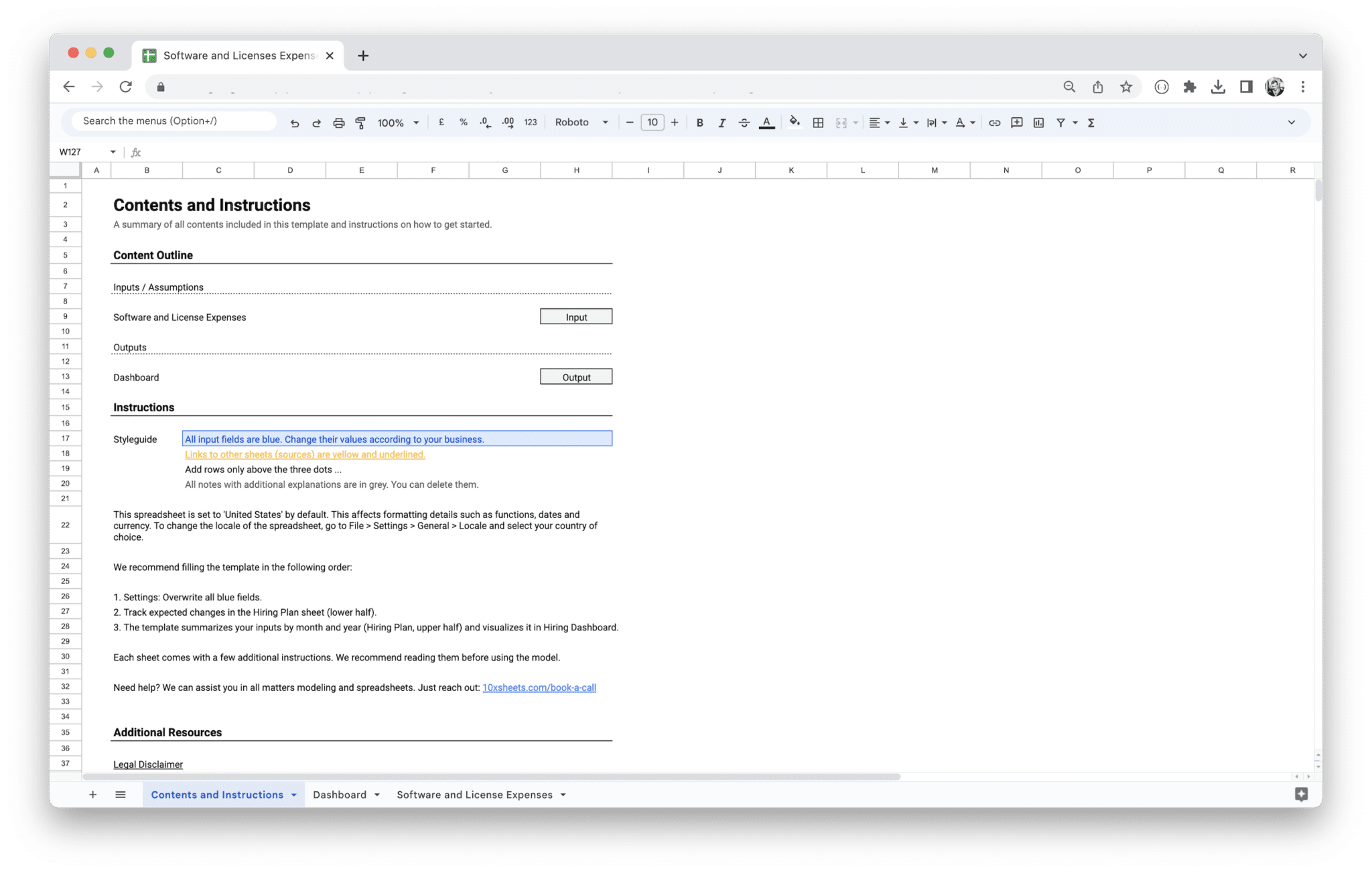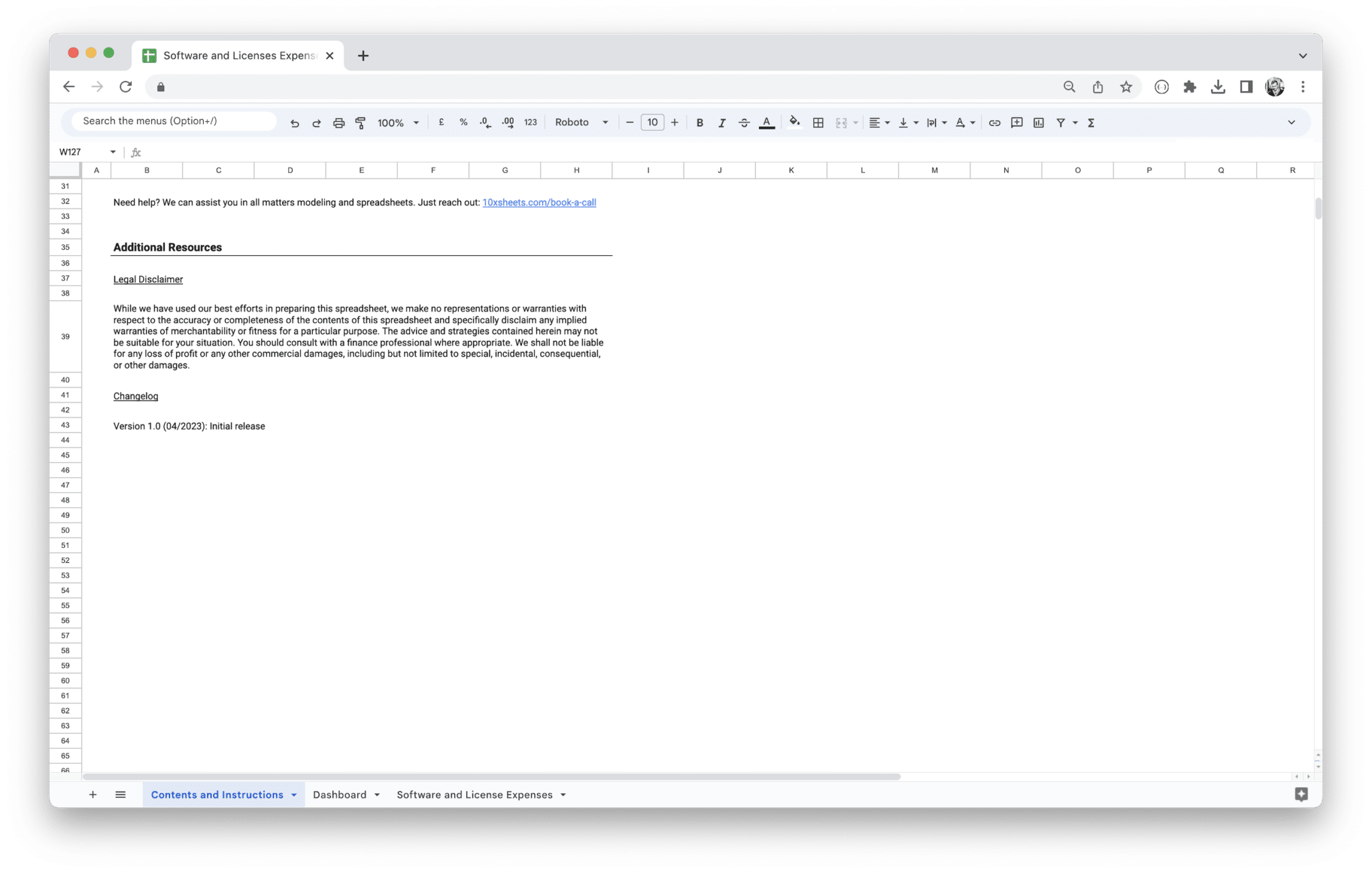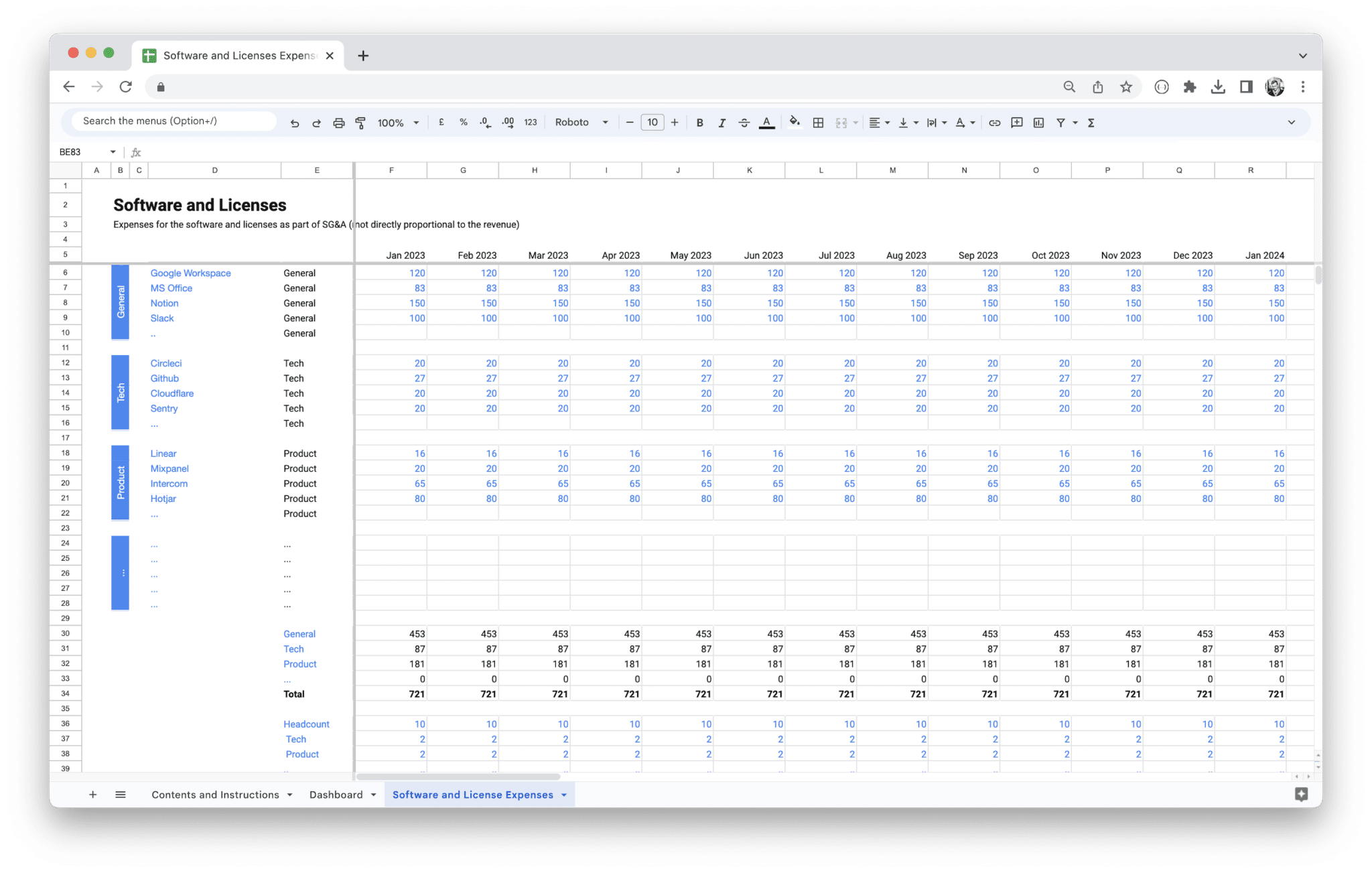Software License Management Tool
0,00 €
Value added tax is not collected, as small businesses according to §19 (1) UStG.
Description
Managing software licenses across your organization can quickly become overwhelming. With multiple vendors, complex contracts, and ever-changing usage requirements, it’s easy to lose track of renewals, miss compliance deadlines, and overspend on unnecessary licenses. The lack of an efficient system can lead to costly mistakes and unnecessary headaches for IT, procurement, and finance teams.
Our Software License Management Tool Template solves these challenges by providing an organized, easy-to-use framework to streamline your license management. This template centralizes all your software license data in one place, ensuring you stay on top of renewal dates, compliance requirements, and usage tracking. It’s fully customizable to meet your specific needs, whether you’re managing a few licenses or thousands. By optimizing your software asset management, this tool helps you reduce costs, improve efficiency, and avoid compliance risks. Stay ahead of renewals, prevent over-licensing, and ensure your software inventory is always accurate with a solution that grows with your business.
Software license management (SLM) is a critical process that involves overseeing and maintaining the lifecycle of software licenses within an organization. As businesses increasingly rely on a variety of software applications to power their operations, effective management of these tools becomes essential to ensure compliance, control costs, and maximize efficiency. Proper software license management involves tracking the licenses, managing their renewals, ensuring compliance with licensing terms, and avoiding over-licensing or under-licensing.
With software often being one of the largest ongoing expenses for businesses, it’s easy to see why managing these assets is not just a legal requirement but also a financial necessity. License management becomes even more important as companies scale, adding more tools and departments that use them. This is where a Software License Management Tool Template comes into play—it helps businesses automate and streamline these processes, saving time and reducing the risk of non-compliance.
What is Software License Management?
Software License Management refers to the process of managing, tracking, and optimizing the software licenses an organization owns or uses. It encompasses activities such as:
- Tracking License Usage: Monitoring how many copies of software are in use at any given time, and ensuring that they are being utilized in compliance with licensing agreements.
- Compliance Management: Ensuring that the company adheres to software vendors’ terms and conditions, avoiding legal complications and audit risks.
- Cost Optimization: Making sure the company is not paying for more licenses than needed, while also ensuring that necessary licenses are in place for proper usage.
- Renewal and Expiry Tracking: Keeping tabs on license expiration dates and ensuring timely renewals to avoid disruptions in service.
- Reporting and Auditing: Generating reports and conducting audits to verify that all licenses are properly accounted for and compliant with regulations.
SLM is important for both financial and legal reasons. Without proper management, companies risk financial penalties, wasted resources, and lost opportunities to renegotiate or optimize their software contracts.
Importance of Software License Management
- Ensures Compliance: Proper license management helps ensure your organization is compliant with software licensing terms, avoiding potential legal issues, fines, or penalties from software audits.
- Reduces Costs: By tracking software usage and optimizing license allocation, you can avoid over-purchasing and ensure that your organization only pays for what it truly needs.
- Minimizes Risk: Mismanagement of licenses can lead to software piracy accusations, data breaches, or service disruptions, which could damage the company’s reputation or expose sensitive data.
- Improves Efficiency: A centralized license management system streamlines processes, making it easier for teams to track, renew, and optimize their software licenses in one place.
- Optimizes Resource Allocation: Understanding the full extent of your software usage allows you to reallocate licenses across departments or employees, ensuring no wasted or unused licenses.
By practicing sound software license management, organizations can ensure that they are compliant, efficient, and cost-effective in their use of software tools.
What is a Software License Management Tool Template?
A Software License Management Tool Template is a pre-built framework designed to help organizations manage their software licenses in a systematic, organized way. This template can come in various forms—spreadsheets, software applications, or integrated tools—and is structured to track and manage all relevant data associated with the software licenses a company holds.
The template typically includes predefined fields for key information such as software name, license type, expiration date, cost, and usage details, as well as features for tracking renewals, audits, and compliance. It provides a simple, user-friendly way for organizations to organize complex software license data and streamline their workflows.
Rather than starting from scratch, a template allows businesses to get started quickly with software license management, ensuring they are tracking all necessary details in one centralized location. Templates can be customized to suit the specific needs of your business, such as adding additional fields for industry-specific compliance or integrating with other business tools.
Key Benefits of Using a License Management Tool Template
- Time Savings: Automating and organizing license management processes saves time compared to manual tracking, allowing teams to focus on higher-priority tasks.
- Improved Compliance: With all your license data centralized and up to date, you can ensure that your organization stays compliant with vendor agreements, reducing the risk of audits or legal issues.
- Cost Efficiency: By accurately tracking usage, renewals, and license allocation, you can avoid over-purchasing, ensuring that you only pay for the licenses you need and freeing up budget for other needs.
- Streamlined Renewals: Automatic reminders and tracking of renewal dates ensure that software licenses don’t expire unexpectedly, preventing service disruptions and late fees.
- Data Transparency: A template provides clear visibility into the status of all software licenses, helping both IT and procurement teams make informed decisions and allocate resources effectively.
- Scalability: As your business grows, the template can be easily adapted to track more licenses, departments, or software vendors, ensuring it remains useful as your software needs evolve.
Using a Software License Management Tool Template streamlines and automates processes that would otherwise be manual and prone to error, creating a more efficient, compliant, and cost-effective system for managing software licenses.
Features to Look for in the SLM Template
- Centralized License Tracking: A tool that consolidates all license information in one location allows for easy access and management, ensuring that your team has full visibility over every software license.
- Automated Alerts and Reminders: Setting up automated reminders for renewals and expirations helps prevent missed deadlines and avoids service interruptions or legal penalties.
- Compliance Management: The ability to track compliance with specific licensing agreements and industry regulations ensures your business stays within the bounds of the law.
- Usage Tracking: Features that allow you to monitor how many licenses are being actively used, so you can ensure that licenses are properly allocated and avoid over-licensing.
- Reporting and Analytics: Built-in reporting features that allow you to generate reports on software usage, costs, and compliance status provide valuable insights to inform purchasing decisions and vendor negotiations.
- Integration with Other Business Tools: A good template integrates with procurement systems, HR platforms, or IT asset management tools, ensuring that software license data flows seamlessly between departments and eliminates manual data entry.
- Customizable Fields: The ability to add custom fields ensures that the template can be adapted to your organization’s specific needs, whether it’s tracking software versions, department assignments, or regulatory compliance details.
- User Access Control: Role-based permissions ensure that sensitive license data is only accessible to authorized personnel, protecting against accidental data modifications or security risks.
- Scalability: As your organization grows, the template should allow you to easily add more software products, users, and licenses without requiring significant reconfiguration or causing performance issues.
When evaluating a Software License Management Tool Template, these features will ensure that your tool not only tracks licenses but also provides valuable insights and supports the ongoing growth and efficiency of your software management process.
When building or adopting a Software License Management (SLM) Tool Template, there are several critical components to ensure that the system works efficiently and covers all the necessary aspects of software license management. A well-organized template should offer comprehensive tracking, secure management, and easy integration with other business functions. Below are the key components that make up a functional and robust license management template.
License Tracking and Inventory
One of the most essential components of a Software License Management Tool Template is the license tracking and inventory system. This feature allows you to keep track of every software license you own, ensuring that you are aware of exactly what you have at any given time. Without an organized inventory, it’s easy to lose track of which licenses are active, expired, or underutilized, which can lead to both compliance issues and wasted resources.
A license inventory system should contain detailed records for each software product, including:
- License Type: The type of license you have for each software. This could be a perpetual license, subscription-based license, volume license, or site-wide license.
- Number of Licenses: This refers to how many copies of the software you are authorized to use. It’s important to distinguish between purchased licenses and the number of licenses currently deployed.
- License Activation and Deactivation: The dates on which licenses were activated and deactivated, as well as any specific terms tied to the usage.
- License Assignment: The specific users, teams, or departments to which each license is assigned. This helps ensure that licenses are being used properly and avoids waste by reallocating unused licenses.
By having an organized inventory, you can easily track your software’s usage and avoid the pitfalls of buying excess licenses or missing renewal deadlines. Additionally, this system provides transparency across departments, ensuring that IT, procurement, and finance teams are all on the same page.
Vendor and Contract Management
Vendor and contract management is another critical element of a Software License Management Tool Template. Software vendors often provide detailed agreements that include important terms such as license scope, duration, renewal options, and specific compliance requirements. Keeping track of all these details manually can lead to misunderstandings, missed deadlines, and unintentional breaches of contract.
A well-structured vendor and contract management system within the template can help ensure that all agreements are well organized and easily accessible. Some key features to consider when it comes to vendor and contract management are:
- Vendor Details: Having a centralized database that stores contact information, contract history, and support details for each software vendor ensures that you can quickly reach out to them when needed.
- Contract Terms: Record and track the essential details of each contract. This includes the start and end dates, licensing limitations, payment terms, and any special clauses like usage restrictions, compliance requirements, and audit rights.
- Renewal and Termination Clauses: Most software contracts include automatic renewal clauses or penalties for early termination. By keeping these details in the template, you can avoid unwanted auto-renewals or negotiate terms before they expire.
- Audit Clauses: Many vendors include audit clauses in their agreements, which allow them to review how their software is being used. Being aware of these clauses helps you prepare for potential audits and ensures you’re always compliant.
With vendor and contract management integrated into your license management template, you not only stay compliant but can also renegotiate contracts more effectively, ensuring your software licensing strategy aligns with your company’s changing needs.
Expiry Date Reminders and Alerts
Another crucial feature of a Software License Management Tool Template is expiry date tracking. Managing software licenses without a system that automatically reminds you of upcoming expirations can be costly. Letting licenses expire unnoticed can result in disruptions to your business, especially if you rely on those tools for critical operations. Missing renewals also risks breaching contractual terms, which could lead to financial penalties or legal action.
A well-designed template should include a robust system for tracking expiration dates and sending timely alerts. These reminders allow your team to take proactive actions well in advance, whether it’s renewing a license, evaluating the software’s continued relevance to the business, or considering alternative options. Alerts can be configured in multiple ways:
- Email Notifications: Set up automatic email reminders for upcoming license expirations. You can define how far in advance you want to be notified (e.g., 30 days, 60 days, 90 days before the expiration).
- Dashboard Reminders: A visual dashboard showing all upcoming license expirations in a calendar format can help provide an at-a-glance view of critical dates.
- Renewal Checkpoints: Your template can create checkpoints where licenses are evaluated. For instance, when a license is nearing its expiration, you might schedule a meeting between the IT and procurement teams to decide whether to renew, cancel, or reassess the software.
Having these reminders in place not only prevents costly mistakes but also helps your team stay on top of regular contract reviews and renewal negotiations. This proactive approach ensures that your software ecosystem remains uninterrupted, compliant, and cost-efficient.
Integration with Other Business Tools
A comprehensive Software License Management Tool Template should not exist in isolation—it should integrate seamlessly with other essential business tools like Human Resources (HR), procurement systems, and finance platforms. These integrations allow for a unified approach to software license management and ensure that all departments involved are working from the same set of data.
- HR Systems: HR and IT departments often need to collaborate when it comes to assigning software licenses to employees. By integrating with HR systems, a software license management tool can automatically sync employee roles and departments with the software they are entitled to use. For example, when a new employee is hired, the system can automatically allocate the necessary licenses, or when an employee leaves, the license can be reassigned or deactivated. This integration streamlines the process, eliminating errors and manual work.
- Procurement Systems: Procurement departments are responsible for acquiring new software and renewing existing licenses. By linking the license management system with procurement tools, you can ensure that purchases align with existing contract terms, track spending, and avoid overbuying. Integrating these systems allows for smoother coordination between procurement and IT, leading to better management of software inventory and spending.
- Finance and Budgeting Tools: Managing the financial aspects of software licenses is key to ensuring that your organization is maximizing its software investments. Integrating your license management tool with finance systems enables seamless tracking of license costs, budgeting, and forecasting. This integration allows finance teams to easily track software spend and compare it against budgeted amounts, helping ensure cost efficiency.
- IT Asset Management: The integration with IT asset management tools ensures that software licenses are being properly deployed across devices. The system can track which software is installed on which machines, allowing IT teams to manage and optimize license distribution and prevent instances of unlicensed or unnecessary installations.
By integrating your license management tool with other business systems, you create a more cohesive and efficient environment for managing software licenses. This integration not only saves time but ensures data accuracy and consistency across all departments. It also makes it easier for teams to collaborate and align on software needs, expenses, and compliance requirements.
A Software License Management Tool Template is much more than just a list of software and licenses. Key components such as license tracking and inventory, vendor and contract management, expiry date reminders and alerts, and integration with other business tools are essential for ensuring that your license management processes run smoothly and efficiently. These components help streamline your operations, reduce the chances of errors or non-compliance, and enable better decision-making around software purchases and renewals. With all the critical information in one place, your company will be well-positioned to manage its software licenses effectively, saving time and resources while staying compliant.
Managing software licenses can be overwhelming, especially as your company grows and diversifies its software usage. With multiple software vendors, various license types, and frequent renewals to manage, staying on top of everything manually can lead to errors, compliance issues, and wasted resources. A Software License Management Tool Template simplifies this process by offering a structured, organized way to track, manage, and optimize your software licenses.
By providing an automated framework for license management, you can focus more on the strategic aspects of IT management while ensuring that your organization remains compliant and cost-effective. Below, we’ll explore how a Software License Management Tool Template can help streamline your processes and reduce unnecessary complexities.
Simplifying Compliance Tracking
Compliance is one of the biggest challenges when it comes to software licensing. Vendors impose strict licensing terms, and failure to adhere to those terms can result in legal and financial consequences. Keeping track of the ever-changing rules and deadlines manually can be time-consuming and prone to mistakes. That’s where a software license management template becomes invaluable.
With an automated template in place, you can easily track all the key compliance data related to your software licenses. A good template consolidates vital information such as license types, purchase dates, renewal dates, and usage limits. This centralized data gives you full visibility into your compliance status, allowing you to quickly identify any discrepancies or licenses that may be approaching expiration.
You can also set automatic alerts and reminders for critical compliance milestones—such as contract renewals, license audits, and compliance checks. These alerts ensure that you never miss a deadline, helping your team stay on top of all necessary actions. For example, if you’re using a subscription-based software license that renews annually, the template will notify you in advance, giving you enough time to review the contract, assess usage, and prepare for the renewal process.
By automating compliance tracking, your team can reduce the burden of manual updates and ensure that all software licenses are used within the legal framework set by the vendor. This can save time, lower the risk of non-compliance, and prevent any legal headaches down the road.
Reducing Risks of Non-Compliance and Audits
Non-compliance is one of the most significant risks associated with software licensing. If your company fails to comply with vendor agreements, you could face hefty fines, legal action, or even be forced to cease using critical software. Moreover, software audits—whether voluntary or triggered by the vendor—can expose non-compliance, leading to reputational damage and unnecessary costs.
A Software License Management Tool Template helps mitigate these risks by keeping a complete and accurate record of your software licenses, contract terms, and usage details. By maintaining this record within a centralized tool, you reduce the likelihood of overlooking critical compliance requirements, such as license limitations, specific terms for usage, or geographical restrictions.
When you’re prepared with accurate and organized information, you’re in a stronger position during an audit. If a software vendor decides to audit your license usage, you can quickly access the necessary records to demonstrate that you’re compliant. For example, if a vendor questions the number of active licenses in use, you can pull a detailed report from the tool, showing exactly how many licenses are assigned and how they’re being used across your organization.
Additionally, templates help ensure that all licenses are aligned with the correct contract terms. By regularly updating and verifying license data, you can reduce the chances of missing key contractual obligations. This proactive approach not only shields you from audit penalties but also enhances your credibility with software vendors, making your organization a trusted, reliable partner.
Managing License Renewals and Expirations
License renewals can be a tricky aspect of software license management. Forgetting to renew a license or letting it expire can disrupt your operations, leading to unexpected downtime or service interruptions. Depending on the software, it could take days or even weeks to restore access. For businesses that rely on software to keep their operations running smoothly, missing renewal deadlines can be catastrophic.
A Software License Management Tool Template removes this risk by providing automatic renewal alerts and expiry tracking. You can configure the template to send reminders well in advance, whether it’s 30 days, 60 days, or even 90 days before the license is set to expire. These reminders allow you to take appropriate actions, such as renewing the license, negotiating better terms, or reassessing whether the software is still required.
For companies with a large number of licenses, manually tracking each renewal date can be a logistical nightmare. However, with a license management template, the process becomes streamlined. The tool can track all licenses and their respective renewal dates, displaying them in a calendar or dashboard view so you can easily see which licenses are up for renewal and when. This visual overview helps you prioritize renewals based on upcoming deadlines, ensuring nothing slips through the cracks.
In addition to renewal tracking, some software license management templates also offer automatic renewals. In these cases, the tool will automatically initiate the renewal process when a license is nearing its expiration date, saving you the trouble of manual intervention. While automatic renewals require vigilance to ensure that the terms remain favorable, they can significantly reduce the administrative burden, especially for essential software that is integral to daily operations.
Cost Optimization through License Allocation
Optimizing costs is another key benefit of using a Software License Management Tool Template. Software licenses can be expensive, especially when you need licenses for multiple users or teams. Without a solid management system in place, organizations often over-purchase or underutilize licenses, wasting money in the process.
A software license management tool helps you optimize your license allocation by providing real-time insights into how many licenses are being used, by whom, and how often. This data allows you to identify any underutilized or redundant licenses. For example, you may discover that a department purchased more licenses than it actually needs, or that some employees are no longer using the software but still have active licenses.
By tracking this information, you can redistribute unused licenses to other departments that require more resources, ensuring that your licenses are being fully utilized. If you find that certain licenses are being overused or underused, you can renegotiate terms with the vendor or explore alternative licensing models that offer better value.
The template can also help you identify which software licenses are cost-effective and which ones may be draining your budget without delivering significant value. Over time, you can use this data to negotiate better pricing, switch to alternative vendors, or consolidate licenses to reduce your software spend.
Moreover, if you’re using software across different departments or business units, the license management template helps you allocate licenses more efficiently. For instance, you may decide that one department needs more licenses for a particular software while another department can make do with fewer. By ensuring that every license is allocated where it’s most needed, you can minimize waste and ensure that your software expenditure aligns with business priorities.
By tracking license usage, optimizing allocations, and renegotiating terms when necessary, a Software License Management Tool Template helps you keep your software costs in check, allowing you to allocate resources more effectively across your organization.
A Software License Management Tool Template can significantly streamline your processes by automating compliance tracking, reducing risks of non-compliance and audits, managing renewals and expirations, and optimizing software license allocation. With this tool in place, you can ensure that your software assets are used efficiently, remain compliant, and contribute to your bottom line without unnecessary costs or headaches.
Every organization has unique software licensing needs based on its size, industry, and operational requirements. While a standard Software License Management Tool Template can cover many general use cases, customization is essential for ensuring that the system aligns with your specific goals and workflows. Customizing your template will not only enhance its relevance to your organization but also improve efficiency and reduce the likelihood of errors or missed deadlines.
Customizing a Software License Management Tool Template allows you to fine-tune the system to track the specific details that matter most to your business. Whether it’s adding custom fields, adapting the system for your industry, managing user access, or preparing for future growth, the flexibility of a well-designed template ensures that your software license management stays aligned with your evolving needs.
Custom Fields and Data Collection
One of the most important steps in customizing your Software License Management Tool Template is setting up custom fields and data collection parameters that reflect your organization’s specific needs. While most templates come with pre-defined fields for basic data—like license type, expiration date, and vendor information—custom fields let you track more granular or organization-specific details.
Custom fields allow you to add tailored information to your license records, ensuring that your template accommodates the nuances of your software environment. Some examples of custom fields that you might want to include are:
- License Owner: The person or team responsible for managing the license. This is particularly useful in larger organizations where multiple stakeholders may be involved with different software products.
- Software Version: Track which versions of software are in use, especially for tools that frequently release updates or patches. This ensures that you’re not using outdated versions, which could pose security risks or become incompatible with other systems.
- Cost Tracking: In addition to recording the purchase cost of each license, you might want to track ongoing fees such as subscription renewals, maintenance, or support costs. This data can help you identify opportunities for cost savings or renegotiating terms with vendors.
- License Usage Metrics: Track not only how many licenses you have but also how many are actively being used at any given time. This allows you to determine whether you have too many unused licenses or need to purchase more based on actual usage.
- Compliance Details: Record any specific compliance or regulatory requirements tied to each software license. For example, healthcare or finance-related software might have strict data privacy regulations that need to be documented.
Custom fields make your license management system more versatile and allow you to collect and analyze data that is relevant to your specific operations. This ensures that the system isn’t just a passive repository of information but a proactive tool for making better decisions about software purchases, renewals, and usage.
Adjusting for Specific Industry Needs
Every industry has its own set of challenges when it comes to software licensing. For instance, industries like healthcare, finance, or education often have stricter compliance requirements that govern the use of software tools. As such, a one-size-fits-all approach to software license management won’t be sufficient. Customizing your template for industry-specific needs is a crucial step to ensure that you remain compliant with all regulations and optimize your software use in the most efficient way.
- Healthcare: In healthcare, you may need to track licenses for specialized medical software that’s subject to HIPAA (Health Insurance Portability and Accountability Act) compliance. The software might require special audit trails, data encryption, and privacy controls that must be documented and monitored. By customizing your template to track these aspects, you can easily ensure that your software licenses are compliant with industry standards.
- Finance: The finance industry is subject to numerous regulations related to data privacy and reporting, such as GDPR (General Data Protection Regulation) or CCPA (California Consumer Privacy Act). In this context, your software license management system should have custom fields that track compliance with these regulations and any vendor-specific terms related to data handling and security.
- Education: Educational institutions often rely on a wide variety of academic software, including learning management systems (LMS) and specialized research tools. In the education sector, your license management template may need to track things like faculty and student access, site licenses, or the number of licenses allocated to specific departments. Customizing your template to reflect these needs ensures that all software licenses are appropriately allocated and utilized.
Customization is about ensuring that the tool reflects your industry’s specific licensing and compliance requirements. By adjusting the template to suit the regulations, workflows, and needs of your industry, you create a more efficient and reliable system that is tailored to your organization’s unique environment.
Adding Role-based Access and Permissions
When managing software licenses in a large organization, it’s crucial to control who has access to the system and what actions they can take. Not everyone in your company needs full administrative access to the license management tool, so adding role-based access and permissions ensures that sensitive information is protected and that users only have access to the areas relevant to their role.
For instance, an IT administrator may need to have full access to the entire software license management system to add new licenses, assign software to departments, and monitor compliance. On the other hand, a department manager may only need to view the licenses assigned to their team and request additional software licenses if needed.
Here are some common roles and permissions you may want to establish:
- Admin: The person or team responsible for overall license management. Admins should have full access to all parts of the tool, including the ability to edit and delete records, manage user roles, and generate reports.
- Manager: Department or team managers may only need access to licenses assigned to their team. They should be able to view the license status, request new licenses, and approve software renewals.
- Employee: Regular employees don’t need access to the software license management system itself but may need a user portal where they can request software, report issues, or confirm software usage. Access should be read-only and limited to basic functions.
- Finance: The finance team needs to have access to cost data and renewal timelines but doesn’t need to alter the software assignments or the technical side of things. They should be able to generate financial reports and monitor spending.
By assigning permissions based on user roles, you ensure that only authorized individuals can modify critical data while still allowing team members to interact with the system as necessary. This keeps sensitive licensing data secure and ensures that employees are using the system in a way that aligns with their responsibilities.
Ensuring Scalability for Future Needs
As your business grows, so will your software licensing needs. The tool you choose should be flexible and scalable enough to accommodate your company’s future needs. A template that works perfectly today might become outdated or inadequate as you expand, either in terms of the number of licenses you manage or the complexity of your software environment.
To ensure scalability, focus on these key aspects:
- Capacity for Growth: Your software license management tool should be able to handle an increasing number of software products and licenses. As your organization adds more employees, departments, and software tools, you should be able to expand your license inventory without running into data limits or system slowdowns.
- Adding New Software Products: Over time, your company may introduce new software tools or switch to different software vendors. Your license management system should be flexible enough to add these new products seamlessly, allowing you to track their licenses, renewals, and compliance requirements.
- Integration with New Systems: As your company evolves, you may implement new IT systems, such as updated procurement tools or HR platforms. Your license management template should be compatible with these systems to ensure smooth integration. Look for templates that allow for easy expansion of integrations or the addition of new modules as your business scales.
- Automation Features: When your software environment becomes more complex, manual processes become inefficient. Look for templates that allow you to automate tasks such as license assignment, renewal reminders, and compliance checks. This will help your team manage an increasing volume of licenses without requiring additional administrative overhead.
- Customizable Reporting: As your company grows, you may need more detailed reporting and analytics capabilities. Ensure your template allows for the creation of custom reports that track key performance metrics, such as license usage, compliance status, and software spend.
A scalable Software License Management Tool Template ensures that your organization can continue to manage software licenses effectively as it grows. By planning for future needs and selecting a template that can expand with your business, you’ll avoid the need for frequent overhauls and ensure that your software management system remains aligned with your organizational goals.
Customizing your Software License Management Tool Template is essential to making it work effectively for your organization. Whether it’s adding custom fields to track data specific to your business, adjusting the system for industry-specific needs, managing access with role-based permissions, or ensuring that the system can grow with your business, customization ensures that your tool remains flexible, accurate, and relevant as your company evolves. A customized system empowers your teams to stay on top of licensing requirements and make informed decisions that benefit your bottom line.
Using a Software License Management Tool Template effectively requires more than simply setting it up. To get the most out of the system and ensure that it benefits your organization, you need to follow best practices that align with both operational needs and compliance requirements. These practices ensure that you maximize the tool’s value, streamline processes, and reduce the risk of costly mistakes.
- Regularly update license data to reflect new acquisitions, changes in software usage, and license renewals: Keeping your software license information accurate and up to date is essential for maintaining compliance and ensuring that you aren’t overspending on unused licenses. It’s critical that your team conducts periodic reviews to ensure data integrity and reflects the current state of your software inventory.
- Monitor software usage across the organization to ensure that licenses are being efficiently allocated: By tracking which departments or employees are actively using certain software, you can identify underutilized licenses and redistribute them as needed, thereby reducing unnecessary costs.
- Coordinate with IT, procurement, and finance teams to keep a unified approach to license management: Collaboration between different departments is key to successful software license management. IT teams will have insights into which software is necessary and how it’s used, procurement will handle the purchase and renewal of licenses, and finance will ensure the cost-effectiveness of software investments. Ensuring that everyone is on the same page will create a smoother process and prevent mistakes or conflicts down the line.
- Set automated alerts for critical events like license expiration, renewal deadlines, and compliance checks: Automated reminders prevent your team from missing important milestones, reducing the risk of software downtime or non-compliance. Set alerts well in advance of renewal dates to ensure there’s enough time to evaluate whether a license should be renewed or reassessed.
- Conduct regular license audits to ensure compliance with vendor agreements and identify any discrepancies: Auditing your licenses periodically helps ensure that you’re staying compliant with vendor agreements and avoid legal issues. These audits also help you track software usage, find expired licenses, and address issues before they become serious problems.
- Utilize reporting features to gain insights into software usage, spending, and license efficiency: Take advantage of your license management tool’s reporting capabilities to analyze your software data. Reports can provide insights into where your company is overspending or underutilizing licenses, helping you make more informed decisions about future software purchases and renewals.
- Implement role-based access to ensure the right people have the right level of access: Not everyone needs to have full control over the license management system. Setting up roles ensures that only those responsible for specific areas, such as IT admins or procurement managers, have the necessary permissions to make changes, while others can view data or request software without making modifications.
- Establish a process for handling license transfers and reassignment to accommodate organizational changes: Employees come and go, and teams may need different software tools as projects evolve. Having a clear and streamlined process for transferring licenses when employees leave or are reassigned helps maintain control over your software inventory and prevents licenses from being wasted.
By adhering to these best practices, you can ensure that your software license management tool remains effective, saves your organization money, and ensures compliance with all necessary regulations.
When adopting a Software License Management Tool Template, it’s easy to overlook certain aspects that can hinder its effectiveness. Whether it’s rushing the setup or neglecting routine checks, small mistakes can snowball into bigger issues that are difficult to resolve later. Avoiding these common mistakes will help you streamline your license management process and maximize the tool’s potential.
- Failing to keep software license data up to date, leading to inaccurate records and unnecessary expenses: As your software inventory changes, it’s essential to continuously update your tool with new acquisitions, renewals, and license deactivations. Outdated data can result in missed renewal deadlines, unused licenses, and wasted software purchases.
- Ignoring integration with other business systems: A license management system that operates in isolation can result in manual processes and duplicated efforts across teams. Failing to integrate with tools like HR systems, procurement software, or financial platforms creates inefficiencies and gaps in your workflow.
- Not setting up automated reminders for key milestones like renewals, expirations, or audits: Manual tracking of renewals and compliance milestones can easily be overlooked. Without automated alerts, your team may miss critical dates, leading to costly penalties or service interruptions.
- Lack of role-based access control, allowing unauthorized users to modify critical data: Having unrestricted access to your license management system increases the risk of errors or unauthorized changes. Not implementing access controls can lead to security vulnerabilities and make it harder to track responsibility for updates or mistakes.
- Overlooking software usage tracking, resulting in unnecessary license purchases or non-compliance: Simply tracking the number of licenses is not enough. Monitoring actual software usage across departments allows you to identify and eliminate redundant or underutilized licenses, optimizing your spending and ensuring compliance.
- Failing to conduct regular audits, leaving non-compliance issues or missed opportunities for cost savings unnoticed: Regular audits are a critical part of software license management. Skipping this step can lead to audit penalties, missed renewals, or compliance violations.
- Rushing through the initial setup without customizing the tool for your organization’s specific needs: Many businesses opt for a generic setup and overlook the benefits of customizing the tool to their unique requirements. Not tailoring the template to your needs, such as adding custom fields or adjusting it for industry-specific compliance, can limit its effectiveness and lead to unnecessary complexities later.
- Not planning for future scalability, causing the system to become inefficient as the organization grows: As your business grows, so do your software needs. Failing to design a scalable system from the outset can result in bottlenecks, data management issues, or increased administrative work as you add more software licenses.
- Neglecting employee training on how to use the tool: Without proper training, your team may not fully utilize the tool’s features or may make costly mistakes. Providing adequate training ensures that everyone knows how to effectively use the system to track licenses, manage renewals, and maintain compliance.
- Underestimating the complexity of software license agreements, leading to compliance risks or missed opportunities for renegotiation: Software contracts often include detailed terms and conditions that can be difficult to navigate. Not thoroughly understanding these agreements or failing to track specific clauses can expose your company to legal and financial risks.
Avoiding these mistakes will help you implement a more efficient, reliable, and cost-effective software license management system that supports both your organization’s operational goals and compliance requirements.
Make a one-time payment and
enjoy your template forever.
No extra costs, no strings attached,
more savings for you.
Keep your templates up-to-date
with free access to regular updates.
Related products
-
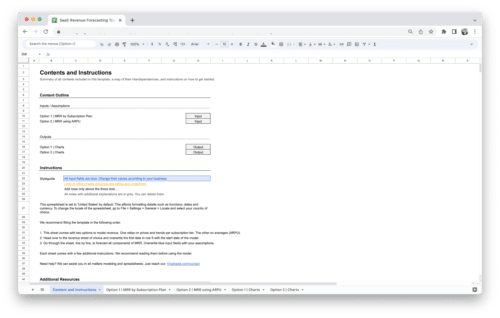
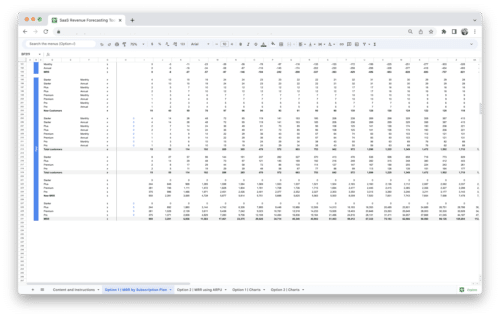
SaaS Revenue Forecasting Tool
41,18 €Value added tax is not collected, as small businesses according to §19 (1) UStG.
Add to cart Details -
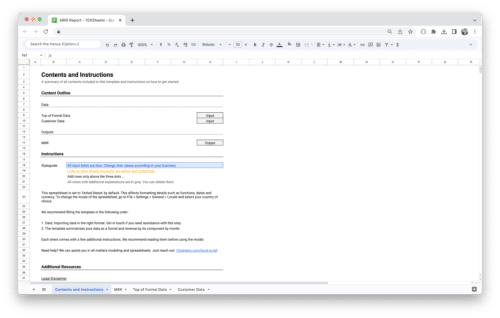
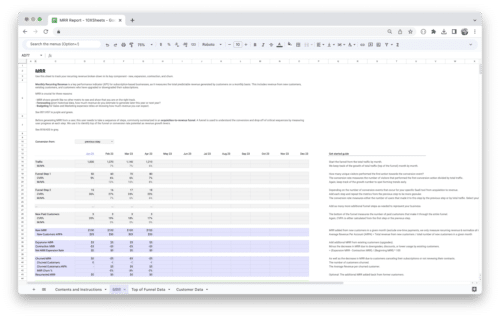
MRR Dashboard Template
0,00 €Value added tax is not collected, as small businesses according to §19 (1) UStG.
Add to cart Details -
Sale!


Marketplace Profit and Loss Statement
100,00 €Original price was: 100,00 €.66,39 €Current price is: 66,39 €.Value added tax is not collected, as small businesses according to §19 (1) UStG.
Add to cart Details -
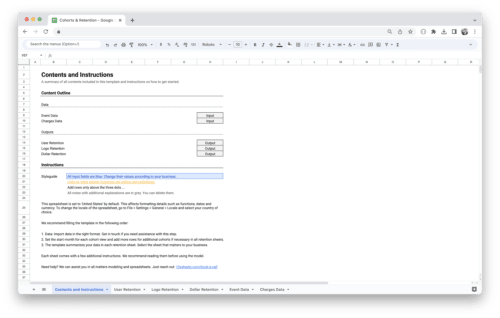
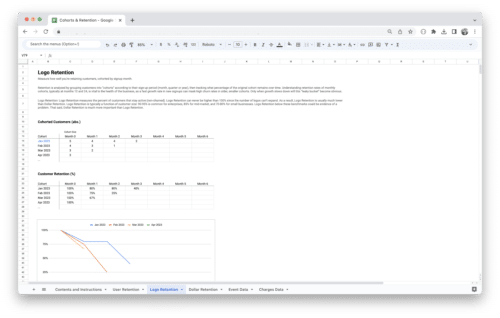
Cohort Analysis Template
0,00 €Value added tax is not collected, as small businesses according to §19 (1) UStG.
Add to cart Details

